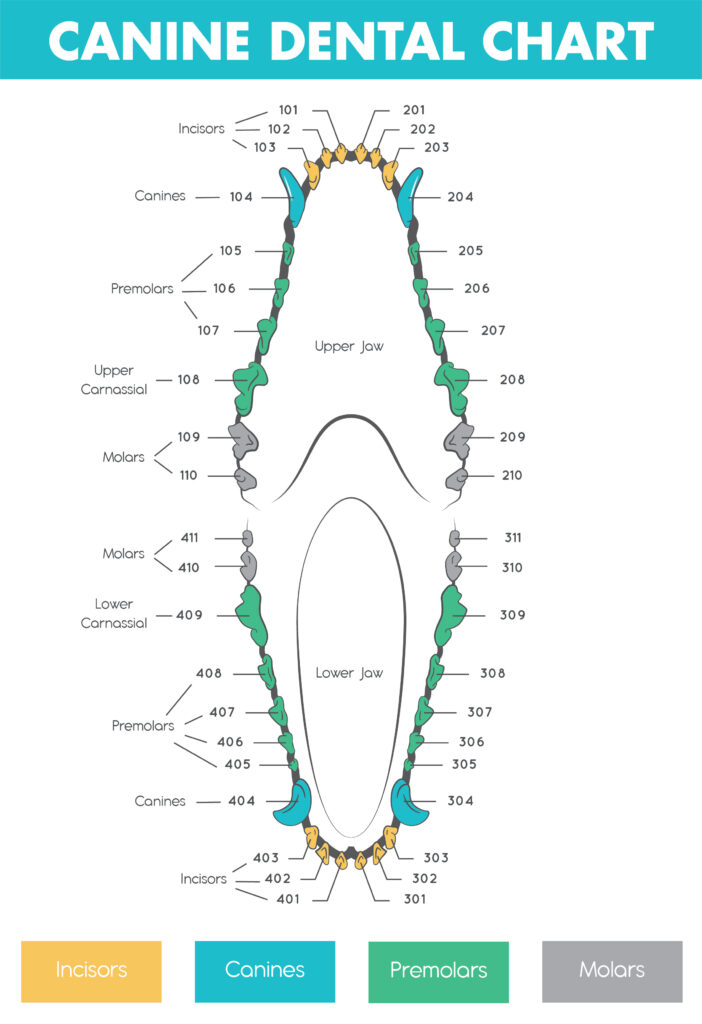Our guide to canine dental care.
Dogs have 42 teeth – that’s 10 more gnashers in their jaw than us humans! Although they start off with only 28 as pups, these puppy teeth will gradually fall out to be replaced by their adult set. Usually you won’t notice this happening, although you might find the odd pearly white around the house.
Whether you’re a first-time pet parent, or an experienced dog owner, it’s worth reading on for tips on looking after your dog’s teeth. Taking care of them now can help to reduce the need for dental treatments down the line.
How to brush dog teeth
Brushing your dog’s teeth helps to keep their gums and teeth healthy by removing bits of food and preventing plaque build-up. This reduces levels of gum inflammation, known as gingivitis. It is best to start from a young age, although older pooches can learn to tolerate toothbrushing if you introduce it gradually. Make sure to use a soft toothbrush to avoid irritating their gums, ideally one that has been designed for use in dogs.

Make toothbrushing a positive experience by taking things slowly, brushing for a few seconds at a time and rewarding with tasty treats. To begin with, we suggest using a toothbrush without any toothpaste as this will help your pet get used to the process without other new distractions and flavours. However, if you aren’t having much luck you can try a special dog toothpaste. These will often be meaty flavoured and some pets love them. Never use human toothpastes as these can contain xylitol, a sweetener that is extremely toxic to pets.
If your pet is having none of it, don’t put yourself at risk of getting a nip. You can speak to a vet or vet nurse for tips on how to hold your pet, and other options for dental care.
How often to brush dog teeth
During the training process, it might work better to brush for short periods a few times a day. However, once you hit a routine daily brushing is recommended. You can even give their teeth a scrub twice a day, and link it to something positive by going for a walk or having a dental chew afterwards.
What to look out for during brushing
As with any home-grooming, toothbrushing can be a great opportunity to spot early signs of health issues. If you notice a lot of plaque on the teeth, the gums are red or bleeding, the teeth look discoloured, or your pet is showing signs of pain then you should speak to a vet for advice.

Dog dental chews vs brushing
Dog dental chew sticks can help to reduce plaque build-up. While they are not designed to replace toothbrushing, they can be a great addition to your pet’s routine as another way to help keep their gums healthier. Opt for products that are designed specifically for dental care, and avoid anything that is too hard as this can lead to tooth fractures. This is one of the reasons that raw or cooked bones are not a suitable option, plus they can cause damage to the digestive tract, or even choking.
Dog teeth chattering
You might notice that your dog chatters their teeth when they are excited. However, this behaviour can also be a sign of worry or feeling threatened. Dogs can even chatter their teeth when they are feeling chilly, just like us hoomins. However, it can also indicate dental pain and if your pet starts doing this more often it is worth speaking to a vet for advice. The same goes for dog teeth grinding, drooling, change in appetite, weight loss, or smelly breath.
What is a dog dental chart?
If your pet has needed veterinary dental treatment, you might have heard the vet mention a dental chart. It is essentially a diagram, almost like a map, of where teeth sit within a dog’s upper and lower jaw. During dentals, the veterinary team might note down some details such as which teeth are showing signs of gum disease, or where there are gaps due to teeth falling out or being extracted.

Smelly breath
Every once in a while, (or more often for some cheeky doggos) our pets eat something unpleasant on a walk – which can lead to stinky breath. However, if it seems to be a longer term issue, then it could signal an underlying problem including dental disease and it’s time for a check up with a vet.
Found these tips helpful? Sign up below to be the first to hear about exclusive pet freebies, and pet care tips.


